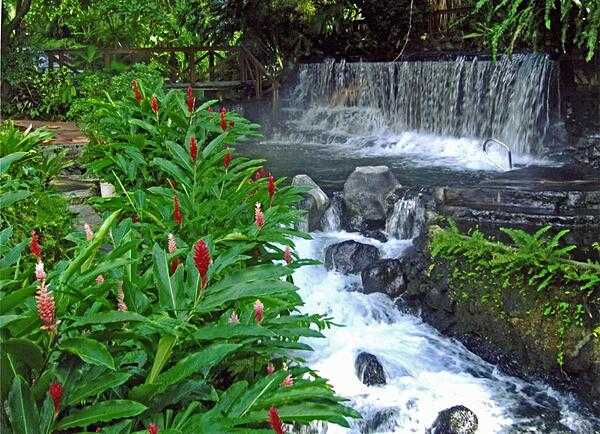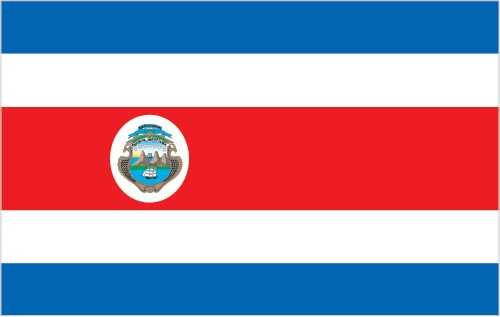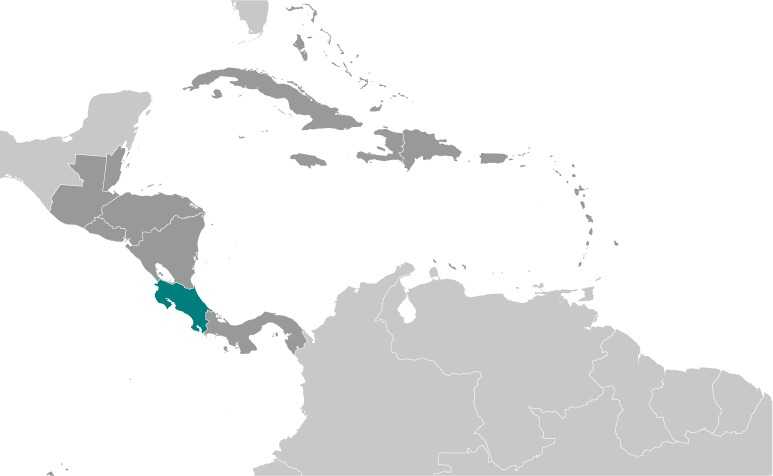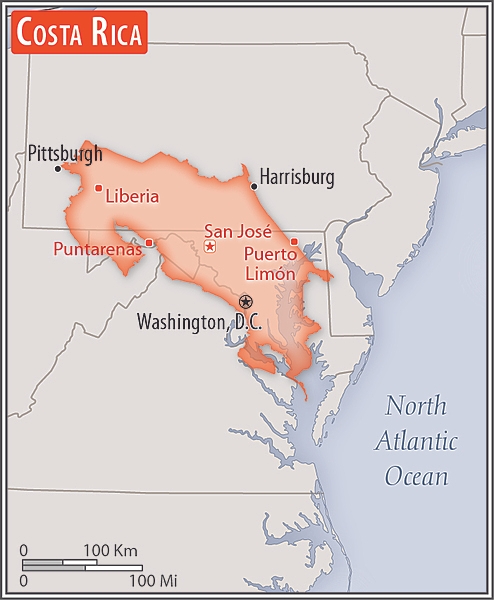Introduction
Background
Although explored by the Spanish early in the 16th century, initial attempts at colonizing Costa Rica proved unsuccessful due to a combination of factors, including disease from mosquito-infested swamps, brutal heat, resistance from Indigenous populations, and pirate raids. It was not until 1563 that a permanent settlement of Cartago was established in the cooler, fertile central highlands. The area remained a colony for some two-and-a-half centuries. In 1821, Costa Rica was one of several Central American provinces that jointly declared independence from Spain. Two years later it joined the United Provinces of Central America, but this federation disintegrated in 1838, at which time Costa Rica proclaimed its sovereignty and independence.
Since the late 19th century, only two brief periods of violence have marred the country's democratic development. General Federico TINOCO Granados led a coup in 1917, but the threat of US intervention pushed him to resign in 1919. In 1948, landowner Jose FIGUERES Ferrer raised his own army and rebelled against the government. The brief civil war ended with an agreement to allow FIGUERES to remain in power for 18 months, then step down in favor of the previously elected Otilio ULATE. FIGUERES was later elected twice in his own right, in 1953 and 1970.
Costa Rica experienced destabilizing waves of refugees from Central American civil wars in the 1970s and 1980s, but peace in the region has since helped the economy rebound. Although it still maintains a large agricultural sector, Costa Rica has expanded its economy to include strong technology and tourism industries.
Visit the Definitions and Notes page to view a description of each topic.
Geography
Location
Central America, bordering both the Caribbean Sea and the North Pacific Ocean, between Nicaragua and Panama
Geographic coordinates
10 00 N, 84 00 W
Map references
Central America and the Caribbean
Area
total : 51,100 sq km
land: 51,060 sq km
water: 40 sq km
note: includes Isla del Coco
comparison ranking: total 129
Land boundaries
total: 661 km
border countries (2): Nicaragua 313 km; Panama 348 km
Coastline
1,290 km
Maritime claims
territorial sea: 12 nm
exclusive economic zone: 200 nm
continental shelf: 200 nm
Climate
tropical and subtropical; dry season (December to April); rainy season (May to November); cooler in highlands
Terrain
coastal plains separated by rugged mountains including over 100 volcanic cones, of which several are major active volcanoes
Elevation
highest point: Cerro Chirripo 3,819 m
lowest point: Pacific Ocean 0 m
mean elevation: 746 m
Natural resources
hydropower
Land use
agricultural land: 37.1% (2018 est.)
arable land: 4.9% (2018 est.)
permanent crops: 6.7% (2018 est.)
permanent pasture: 25.5% (2018 est.)
forest: 51.5% (2018 est.)
other: 11.4% (2018 est.)
Irrigated land
1,015 sq km (2012)
Population distribution
roughly half of the nation's population resides in urban areas; the capital of San Jose is the largest city and home to approximately one-fifth of the population
Natural hazards
occasional earthquakes, hurricanes along Atlantic coast; frequent flooding of lowlands at onset of rainy season and landslides; active volcanoes
volcanism: Arenal (1,670 m), which erupted in 2010, is the most active volcano in Costa Rica; a 1968 eruption destroyed the town of Tabacon; Irazu (3,432 m), situated just east of San Jose, has the potential to spew ash over the capital city as it did between 1963 and 1965; other historically active volcanoes include Miravalles, Poas, Rincon de la Vieja, and Turrialba
Geography - note
four volcanoes, two of them active, rise near the capital of San Jose in the center of the country; one of the volcanoes, Irazu, erupted destructively in 1963-65
People and Society
Population
total: 5,265,575
male: 2,635,481
female: 2,630,094 (2024 est.)
comparison rankings: female 124; male 123; total 123
Nationality
noun: Costa Rican(s)
adjective: Costa Rican
Ethnic groups
White or Mestizo 83.6%, Mulatto 6.7%, Indigenous 2.4%, Black or African descent 1.1%, other 1.1%, none 2.9%, unspecified 2.2% (2011 est.)
Languages
Spanish (official), English
major-language sample(s):
La Libreta Informativa del Mundo, la fuente indispensable de información básica. (Spanish)
The World Factbook, the indispensable source for basic information.
Religions
Roman Catholic 47.5%, Evangelical and Pentecostal 19.8%, Jehovah's Witness 1.4%, other Protestant 1.2%, other 3.1%, none 27% (2021 est.)
Demographic profile
Costa Rica's political stability, high standard of living, and well-developed social benefits system set it apart from its Central American neighbors. Through the government's sustained social spending - almost 20% of GDP annually - Costa Rica has made tremendous progress toward achieving its goal of providing universal access to education, healthcare, clean water, sanitation, and electricity. Since the 1970s, expansion of these services has led to a rapid decline in infant mortality, an increase in life expectancy at birth, and a sharp decrease in the birth rate. The average number of children born per women has fallen from about 7 in the 1960s to 3.5 in the early 1980s to below replacement level today. Costa Rica's poverty rate is lower than in most Latin American countries, but it has stalled at around 20% for almost two decades.
Costa Rica is a popular regional immigration destination because of its job opportunities and social programs. Almost 9% of the population is foreign-born, with Nicaraguans comprising nearly three-quarters of the foreign population. Many Nicaraguans who perform unskilled seasonal labor enter Costa Rica illegally or overstay their visas, which continues to be a source of tension. Less than 3% of Costa Rica's population lives abroad. The overwhelming majority of expatriates have settled in the United States after completing a university degree or in order to work in a highly skilled field.
Age structure
0-14 years: 18.8% (male 506,041/female 482,481)
15-64 years: 70.2% (male 1,862,872/female 1,832,024)
65 years and over: 11.1% (2024 est.) (male 266,568/female 315,589)
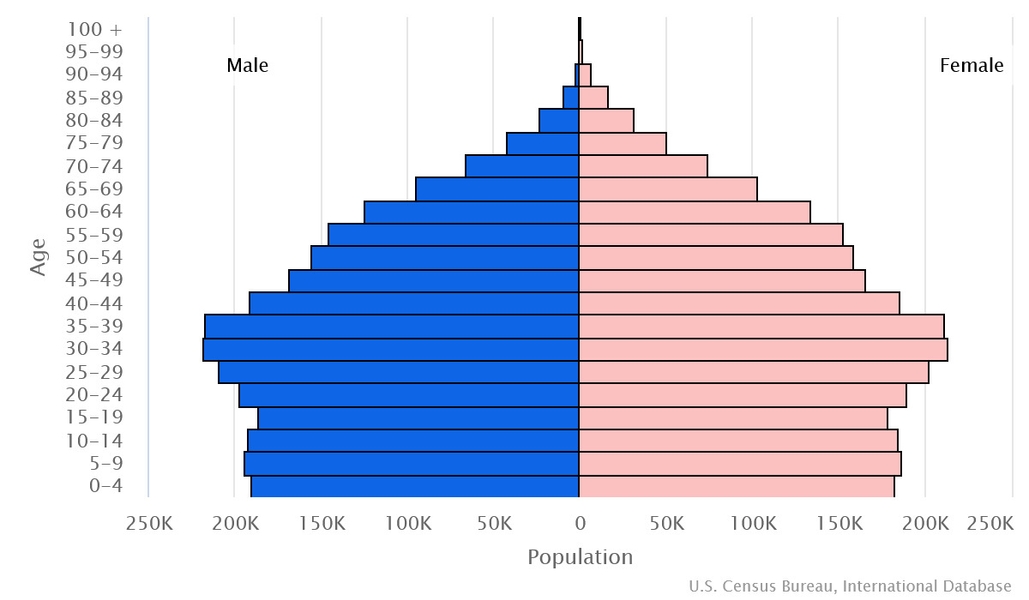
Dependency ratios
total dependency ratio: 45.1
youth dependency ratio: 29.8
elderly dependency ratio: 15.3
potential support ratio: 6.5 (2021 est.)
Median age
total: 35.5 years (2024 est.)
male: 34.9 years
female: 36.1 years
comparison ranking: total 96
Population distribution
roughly half of the nation's population resides in urban areas; the capital of San Jose is the largest city and home to approximately one-fifth of the population
Urbanization
urban population: 82.6% of total population (2023)
rate of urbanization: 1.5% annual rate of change (2020-25 est.)
Major urban areas - population
1.462 million SAN JOSE (capital) (2023)
Sex ratio
at birth: 1.05 male(s)/female
0-14 years: 1.05 male(s)/female
15-64 years: 1.02 male(s)/female
65 years and over: 0.84 male(s)/female
total population: 1 male(s)/female (2024 est.)
Infant mortality rate
total: 6.7 deaths/1,000 live births (2024 est.)
male: 7 deaths/1,000 live births
female: 6.3 deaths/1,000 live births
comparison ranking: total 158
Life expectancy at birth
total population: 80.3 years (2024 est.)
male: 77.7 years
female: 82.9 years
comparison ranking: total population 54
Gross reproduction rate
0.7 (2024 est.)
Contraceptive prevalence rate
70.9% (2018)
Drinking water source
improved: urban: 100% of population
rural: 100% of population
total: 100% of population
unimproved: urban: 0% of population
rural: 0% of population
total: 0% of population (2020 est.)
Current health expenditure
7.9% of GDP (2020)
Physician density
3.3 physicians/1,000 population (2020)
Hospital bed density
1.1 beds/1,000 population (2019)
Sanitation facility access
improved: urban: 99% of population
rural: 97.1% of population
total: 98.7% of population
unimproved: urban: 1% of population
rural: 2.9% of population
total: 1.3% of population (2020 est.)
Major infectious diseases
degree of risk: intermediate (2023)
food or waterborne diseases: bacterial diarrhea
vectorborne diseases: dengue fever
Alcohol consumption per capita
total: 3.07 liters of pure alcohol (2019 est.)
beer: 2.17 liters of pure alcohol (2019 est.)
wine: 0.15 liters of pure alcohol (2019 est.)
spirits: 0.36 liters of pure alcohol (2019 est.)
other alcohols: 0.39 liters of pure alcohol (2019 est.)
comparison ranking: total 113
Tobacco use
total: 8.8% (2020 est.)
male: 12.9% (2020 est.)
female: 4.6% (2020 est.)
comparison ranking: total 140
Currently married women (ages 15-49)
48.4% (2023 est.)
Child marriage
women married by age 15: 2%
women married by age 18: 17.1% (2018 est.)
Literacy
definition: age 15 and over can read and write
total population: 98%
male: 98%
female: 98.1% (2021)
School life expectancy (primary to tertiary education)
total: 17 years
male: 16 years
female: 17 years (2019)
Environment
Environment - current issues
deforestation and land use change, largely a result of the clearing of land for cattle ranching and agriculture; soil erosion; coastal marine pollution; fisheries protection; solid waste management; air pollution
Environment - international agreements
party to: Biodiversity, Climate Change, Climate Change-Kyoto Protocol, Climate Change-Paris Agreement, Comprehensive Nuclear Test Ban, Desertification, Endangered Species, Environmental Modification, Hazardous Wastes, Law of the Sea, Marine Dumping-London Convention, Nuclear Test Ban, Ozone Layer Protection, Tropical Timber 2006, Wetlands, Whaling
signed, but not ratified: Marine Life Conservation
Climate
tropical and subtropical; dry season (December to April); rainy season (May to November); cooler in highlands
Land use
agricultural land: 37.1% (2018 est.)
arable land: 4.9% (2018 est.)
permanent crops: 6.7% (2018 est.)
permanent pasture: 25.5% (2018 est.)
forest: 51.5% (2018 est.)
other: 11.4% (2018 est.)
Urbanization
urban population: 82.6% of total population (2023)
rate of urbanization: 1.5% annual rate of change (2020-25 est.)
Air pollutants
particulate matter emissions: 14.7 micrograms per cubic meter (2019 est.)
carbon dioxide emissions: 8.02 megatons (2016 est.)
methane emissions: 5.61 megatons (2020 est.)
Waste and recycling
municipal solid waste generated annually: 1.46 million tons (2014 est.)
municipal solid waste recycled annually: 18,396 tons (2014 est.)
percent of municipal solid waste recycled: 1.3% (2014 est.)
Total water withdrawal
municipal: 830 million cubic meters (2020 est.)
industrial: 230 million cubic meters (2020 est.)
agricultural: 2.08 billion cubic meters (2020 est.)
Total renewable water resources
113 billion cubic meters (2020 est.)
Government
Country name
conventional long form: Republic of Costa Rica
conventional short form: Costa Rica
local long form: República de Costa Rica
local short form: Costa Rica
etymology: the name means "rich coast" in Spanish and was first applied in the early colonial period of the 16th century
Government type
presidential republic
Capital
name: San José
geographic coordinates: 9 56 N, 84 05 W
time difference: UTC-6 (1 hour behind Washington, DC, during Standard Time)
etymology: named in honor of Saint Joseph
Administrative divisions
7 provinces (provincias, singular - provincia); Alajuela, Cartago, Guanacaste, Heredia, Limon, Puntarenas, San Jose
Independence
15 September 1821 (from Spain)
National holiday
Independence Day, 15 September (1821)
Constitution
history: many previous; latest effective 8 November 1949
amendments: proposals require the signatures of at least 10 Legislative Assembly members or petition of at least 5% of qualified voters; consideration of proposals requires two-thirds majority approval in each of three readings by the Assembly, followed by preparation of the proposal as a legislative bill and its approval by simple majority of the Assembly; passage requires at least two-thirds majority vote of the Assembly membership; a referendum is required only if approved by at least two thirds of the Assembly; amended many times, last in 2020
Legal system
civil law system based on Spanish civil code; judicial review of legislative acts in the Supreme Court
International law organization participation
accepts compulsory ICJ jurisdiction; accepts ICCt jurisdiction
Citizenship
citizenship by birth: yes
citizenship by descent only: yes
dual citizenship recognized: yes
residency requirement for naturalization: 7 years
Suffrage
18 years of age; universal and compulsory
Executive branch
chief of state: President Rodrigo CHAVES Robles (since 8 May 2022)
head of government: President Rodrigo CHAVES Robles (since 8 May 2022)
cabinet: Cabinet selected by the president
elections/appointments: president and vice presidents directly elected on the same ballot by modified majority popular vote (40% threshold) for a 4-year term (eligible for non-consecutive terms); election last held on 6 February 2022 with a runoff on 3 April 2022 (next to be held in February 2026 with a runoff in April 2026)
election results:
2022: Rodrigo CHAVES Robles elected president in second round; percent of vote in first round - Jose Maria FIGUERES Olsen (PLN) 27.3%, Rodrigo CHAVES Robles (PPSD) 16.8%, Fabricio ALVARADO Munoz (PNR) 14.9%, Eliecer FEINZAIG Mintz (PLP) 12.4%, Lineth SABORIO Chaverri (PUSC) 12.4%, Jose Maria VILLALTA Florez-Estrada 8.7% (PFA), other 7.5%; percent of vote in second round - Rodrigo CHAVES Robles (PPSD) 52.8%, Jose Maria FIGUERES Olsen (PLN) 47.2%
2018: Carlos ALVARADO Quesada elected president in second round; percent of vote in first round - Fabricio ALVARADO Munoz (PRN) 25%; Carlos ALVARADO Quesada (PAC) 21.6%; Antonio ALVAREZ (PLN) 18.6%; Rodolfo PIZA (PUSC) 16%; Juan Diego CASTRO (PIN) 9.5%; Rodolfo HERNANDEZ (PRSC) 4.9%, other 4.4%; percent of vote in second round - Carlos ALVARADO Quesada (PAC) 60.7%; Fabricio ALVARADO Munoz (PRN) 39.3%
note: the president is both chief of state and head of government
Legislative branch
description: unicameral Legislative Assembly or Asamblea Legislativa (57 seats; members directly elected in multi-seat constituencies - corresponding to the country's 7 provinces - by closed party-list proportional representation vote; members serve 4-year terms)
elections: last held on 6 February 2022 (next to be held in February 2026)
election results: percent of vote by party - PLN 24.8%, PPSD 15%, PUSC 11.4%, PNR 10.1%, PLP 9.1%, 8.3%, other 21.3%; seats by party - PLN 19, PPSD 10, PUSC 9, PNR 7, PLP 6, PFA 6; composition - men 30, women 27, percentage women 47.4%
Judicial branch
highest court(s): Supreme Court of Justice (consists of 22 judges organized into 3 cassation chambers each with 5 judges and the Constitutional Chamber with 7 judges)
judge selection and term of office: Supreme Court of Justice judges elected by the National Assembly for 8-year terms with renewal decided by the National Assembly
subordinate courts: appellate courts; trial courts; first instance and justice of the peace courts; Superior Electoral Tribunal
Political parties and leaders
Accessibility Without Exclusion or PASE [Oscar Andres LOPEZ Arias]
Broad Front (Frente Amplio) or PFA [Ana Patricia MORA Castellanos]
Citizen Action Party or PAC [Fabian SOLANO Fernandez]
Costa Rican Renewal Party or PRC [Justo OROZCO Alvarez]
Here Costa Rica Commands Party or ACRM [Federico CRUZ Saravanja]
Liberal Progressive Party or PLP [Eliecer FEINZAIG Mintz]
Libertarian Movement Party or ML [Victor Danilo CUBERO Corrales]
National Integration Party or PIN [Walter MUNOZ Cespedes]
National Liberation Party or PLN [Ricardo SANCHO Chavarría]
National Restoration Party or PRN [Carlos Luis AVENDANO Calvo]
New Generation or PNG [Rodolfo SOLIS Herrera]
New Republic Party or PNR [Fabricio ALVARADO Muñoz]
Social Christian Republican Party or PRSC [Otto ROBERTO Vargas]
Social Christian Unity Party or PUSC of UNIDAD [Juan Carlos HIDALGO Bogantes]
Social Democratic Progress Party or PPSD [Luz Mary ALPIZAR Loaiza]
International organization participation
ACS, BCIE, CACM, CD, CELAC, FAO, G-77, IADB, IAEA, IBRD, ICAO, ICC (national committees), ICCt, ICRM, IDA, IFAD, IFC, IFRCS, ILO, IMF, IMO, IMSO, Interpol, IOC, IOM, IPU, ISO, ITSO, ITU, ITUC (NGOs), LAES, LAIA (observer), MIGA, NAM (observer), OAS, OIF (observer), OPANAL, OPCW, Pacific Alliance (observer), PCA, SICA, UN, UNCTAD, UNESCO, UNHCR, UNIDO, Union Latina, UNOOSA, UNWTO, UPU, WCO, WFTU (NGOs), WHO, WIPO, WMO, WTO
Diplomatic representation in the US
chief of mission: Ambassador Catalina CRESPO SANCHO (since 19 April 2023)
chancery: 2114 S Street NW, Washington, DC 20008
telephone: [1] (202) 499-2980
FAX: [1] (202) 265-4795
email address and website:
embcr-us@rree.go.cr
http://www.costarica-embassy.org/index.php?q=node/21
consulate(s) general: Atlanta, Houston, Los Angeles, Miami, New York, Washington DC
Diplomatic representation from the US
chief of mission: Ambassador Cynthia A. TELLES (since 11 March 2022)
embassy: Calle 98 Via 104, Pavas, San Jose
mailing address: 3180 St. George's Place, Washington DC 20521-3180
telephone: [506] 2519-2000
FAX: [506] 2519-2305
email address and website:
acssanjose@state.gov
https://cr.usembassy.gov/
Flag description
five horizontal bands of blue (top), white, red (double width), white, and blue, with the coat of arms in a white elliptical disk placed toward the hoist side of the red band; Costa Rica retained the earlier blue-white-blue flag of Central America until 1848 when, in response to revolutionary activity in Europe, it was decided to incorporate the French colors into the national flag and a central red stripe was added; today the blue color is said to stand for the sky, opportunity, and perseverance, white denotes peace, happiness, and wisdom, while red represents the blood shed for freedom, as well as the generosity and vibrancy of the people
note: somewhat resembles the flag of North Korea; similar to the flag of Thailand but with the blue and red colors reversed
National symbol(s)
yiguirro (clay-colored robin); national colors: blue, white, red
National anthem
name: "Himno Nacional de Costa Rica" (National Anthem of Costa Rica)
lyrics/music: Jose Maria ZELEDON Brenes/Manuel Maria GUTIERREZ
note: adopted 1949; the anthem's music was originally written for an 1853 welcome ceremony for diplomatic missions from the US and UK; the lyrics were added in 1903
National heritage
total World Heritage Sites: 4 (1 cultural, 3 natural)
selected World Heritage Site locales: Guanacaste Conservation Area (n); Cocos Island National Park (n); Precolumbian Stone Spheres (c); La Amistad International Park (n)
Economy
Economic overview
trade-based upper middle-income economy; green economy leader, having reversed deforestation; investing in blue economy infrastructure; declining poverty until hard impacts of COVID-19; lingering inequality and growing government debts have prompted a liquidity crisis
Real GDP (purchasing power parity)
$134.238 billion (2023 est.)
$127.71 billion (2022 est.)
$122.15 billion (2021 est.)
note: data in 2021 dollars
comparison ranking: 90
Real GDP growth rate
5.11% (2023 est.)
4.55% (2022 est.)
7.94% (2021 est.)
note: annual GDP % growth based on constant local currency
comparison ranking: 50
Real GDP per capita
$25,800 (2023 est.)
$24,700 (2022 est.)
$23,700 (2021 est.)
note: data in 2021 dollars
comparison ranking: 89
GDP (official exchange rate)
$86.498 billion (2023 est.)
note: data in current dollars at official exchange rate
Inflation rate (consumer prices)
0.53% (2023 est.)
8.27% (2022 est.)
1.73% (2021 est.)
note: annual % change based on consumer prices
comparison ranking: 13
Credit ratings
Fitch rating: B (2020)
Moody's rating: B2 (2020)
Standard & Poors rating: B (2020)
note: The year refers to the year in which the current credit rating was first obtained.
GDP - composition, by sector of origin
agriculture: 5.5% (2017 est.)
industry: 20.6% (2017 est.)
services: 73.9% (2017 est.)
comparison rankings: services 53; industry 143; agriculture 125
GDP - composition, by end use
household consumption: 64.2% (2017 est.)
government consumption: 17.3% (2017 est.)
investment in fixed capital: 17.1% (2017 est.)
investment in inventories: 1% (2017 est.)
exports of goods and services: 33.3% (2017 est.)
imports of goods and services: -32.9% (2017 est.)
Agricultural products
sugarcane, pineapples, bananas, milk, oil palm fruit, fruits, oranges, chicken, cassava, rice (2022)
note: top ten agricultural products based on tonnage
Industries
medical equipment, food processing, textiles and clothing, construction materials, fertilizer, plastic products
Industrial production growth rate
8.35% (2023 est.)
note: annual % change in industrial value added based on constant local currency
comparison ranking: 27
Labor force
2.408 million (2023 est.)
note: number of people ages 15 or older who are employed or seeking work
comparison ranking: 121
Unemployment rate
8.3% (2023 est.)
11.33% (2022 est.)
15.14% (2021 est.)
note: % of labor force seeking employment
comparison ranking: 152
Youth unemployment rate (ages 15-24)
total: 45.4% (2021 est.)
male: 37%
female: 56.3%
comparison ranking: total 6
Population below poverty line
25.5% (2022 est.)
note: % of population with income below national poverty line
Gini Index coefficient - distribution of family income
47.2 (2022 est.)
note: index (0-100) of income distribution; higher values represent greater inequality
comparison ranking: 17
Average household expenditures
on food: 31.6% of household expenditures (2021 est.)
on alcohol and tobacco: 0.7% of household expenditures (2021 est.)
Household income or consumption by percentage share
lowest 10%: 1.7% (2022 est.)
highest 10%: 35.7% (2022 est.)
note: % share of income accruing to lowest and highest 10% of population
Remittances
0.73% of GDP (2023 est.)
0.9% of GDP (2022 est.)
0.91% of GDP (2021 est.)
note: personal transfers and compensation between resident and non-resident individuals/households/entities
Budget
revenues: $9.664 billion (2019 est.)
expenditures: $14.001 billion (2019 est.)
Public debt
71.11% of GDP (2022 est.)
48.9% of GDP (2017 est.)
44.9% of GDP (2016 est.)
comparison ranking: 53
Taxes and other revenues
14.35% (of GDP) (2022 est.)
note: central government tax revenue as a % of GDP
comparison ranking: 151
Current account balance
-$844.64 million (2023 est.)
-$2.235 billion (2022 est.)
-$2.061 billion (2021 est.)
note: balance of payments - net trade and primary/secondary income in current dollars
comparison ranking: 136
Exports
$33.699 billion (2023 est.)
$29.404 billion (2022 est.)
$23.609 billion (2021 est.)
note: balance of payments - exports of goods and services in current dollars
comparison ranking: 77
Exports - partners
US 40%, Netherlands 7%, Guatemala 5%, Belgium 5%, Nicaragua 3% (2022)
note: top five export partners based on percentage share of exports
Exports - commodities
medical instruments, orthopedic appliances, bananas, tropical fruits, other foods (2022)
note: top five export commodities based on value in dollars
Imports
$28.441 billion (2023 est.)
$27.07 billion (2022 est.)
$21.94 billion (2021 est.)
note: balance of payments - imports of goods and services in current dollars
comparison ranking: 83
Imports - partners
US 39%, China 14%, Mexico 5%, Guatemala 3%, Brazil 3% (2022)
note: top five import partners based on percentage share of imports
Imports - commodities
refined petroleum, plastic products, medical instruments, cars, broadcasting equipment (2022)
note: top five import commodities based on value in dollars
Reserves of foreign exchange and gold
$13.225 billion (2023 est.)
$8.554 billion (2022 est.)
$6.921 billion (2021 est.)
note: holdings of gold (year-end prices)/foreign exchange/special drawing rights in current dollars
comparison ranking: 79
Exchange rates
Costa Rican colones (CRC) per US dollar -
Exchange rates:
544.051 (2023 est.)
647.136 (2022 est.)
620.785 (2021 est.)
584.901 (2020 est.)
587.295 (2019 est.)
Energy
Electricity access
electrification - total population: 100% (2022 est.)
Electricity
installed generating capacity: 3.692 million kW (2022 est.)
consumption: 10.619 billion kWh (2022 est.)
exports: 773.979 million kWh (2022 est.)
imports: 54.231 million kWh (2022 est.)
transmission/distribution losses: 1.14 billion kWh (2022 est.)
comparison rankings: transmission/distribution losses 104; imports 114; exports 70; consumption 100; installed generating capacity 104
Electricity generation sources
solar: 0.6% of total installed capacity (2022 est.)
wind: 11% of total installed capacity (2022 est.)
hydroelectricity: 75% of total installed capacity (2022 est.)
geothermal: 11.9% of total installed capacity (2022 est.)
biomass and waste: 1.5% of total installed capacity (2022 est.)
Coal
consumption: 30,000 metric tons (2022 est.)
exports: (2022 est.) less than 1 metric ton
imports: 500 metric tons (2022 est.)
Petroleum
total petroleum production: 400 bbl/day (2023 est.)
refined petroleum consumption: 62,000 bbl/day (2022 est.)
Carbon dioxide emissions
7.966 million metric tonnes of CO2 (2022 est.)
from coal and metallurgical coke: 74,000 metric tonnes of CO2 (2022 est.)
from petroleum and other liquids: 7.892 million metric tonnes of CO2 (2022 est.)
comparison ranking: total emissions 119
Communications
Telephones - fixed lines
total subscriptions: 492,000 (2022 est.)
subscriptions per 100 inhabitants: 9 (2022 est.)
comparison ranking: total subscriptions 92
Telephones - mobile cellular
total subscriptions: 7.876 million (2022 est.)
subscriptions per 100 inhabitants: 152 (2022 est.)
comparison ranking: total subscriptions 103
Telecommunication systems
general assessment: the fixed broadband market is one of the few parts of Costa Rica’s telecom sector to experience solid growth in recent years, both in size and revenue; the country’s fiber network expanded by 56% in 2020, reaching about 176,200km; fixed-line broadband traffic volume also increased by more than 30%, year-on-year; other areas of the market have proven relatively lack luster, with slow or even negative growth; some of this can be attributed to the economic and social impacts of the pandemic, but the fixed-line and mobile sectors have both been struggling to produce decent results since well before the start of the crisis; the rollout of 5G network infrastructure in Costa Rica is unlikely to occur to any scale before 2023, but this may be one of the few remaining areas of opportunity open to investors outside of fixed-line internet and pay TV services (2021)
domestic: roughly 11 per 100 fixed-line and 152 per 100 mobile-cellular (2021)
international: country code - 506; landing points for the ARCOS-1, MAYA-1, and the PAC submarine cables that provide links to South and Central America, parts of the Caribbean, and the US; connected to Central American Microwave System; satellite earth stations - 2 Intelsat (Atlantic Ocean) (2019)
Broadcast media
over two dozen privately owned TV stations and 1 publicly owned TV station nationwide; cable network services are widely available; more than 100 privately owned radio stations and a public radio network (2022)
Internet users
total: 4.316 million (2021 est.)
percent of population: 83% (2021 est.)
comparison ranking: total 106
Broadband - fixed subscriptions
total: 992,725 (2020 est.)
subscriptions per 100 inhabitants: 20 (2020 est.)
comparison ranking: total 74
Transportation
National air transport system
number of registered air carriers: 1 (2020)
inventory of registered aircraft operated by air carriers: 39
annual passenger traffic on registered air carriers: 1,948,546 (2018)
annual freight traffic on registered air carriers: 11.13 million (2018) mt-km
Heliports
8 (2024)
Pipelines
662 km refined products (2013)
Railways
total: 278 km (2014)
narrow gauge: 278 km (2014) 1.067-m gauge
note: the entire rail network fell into disrepair and out of use at the end of the 20th century; since 2005, certain sections of rail have been rehabilitated
comparison ranking: total 124
Ports
total ports: 6 (2024)
large: 0
medium: 0
small: 1
very small: 5
ports with oil terminals: 4
key ports: Golfito, Puerto Caldera, Puerto Limon, Puerto Moin, Puerto Quepos, Puntarenas
Military and Security
Military and security forces
no regular military forces; Ministry of Public Security: National Police (Fuerza Pública), Air Surveillance Service (Servicio de Vigilancia Aérea), National Coast Guard Service (Servicio Nacional de Guardacostas), Drug Control Police (Policía Control de Drogas), Border Police (Policia de Fronteras), Professional Migration Police (Policía Profesional de Migración); Ministry of Presidency: Directorate of Intelligence and Security (DIS), Special Intervention Unit (UEI) (2024)
note: Costa Rica's armed forces were constitutionally abolished in 1949
Military expenditures
0.6% of GDP (2023 est.)
0.6% of GDP (2022 est.)
0.7% of GDP (2021 est.)
0.7% of GDP (2020 est.)
0.7% of GDP (2019 est.)
comparison ranking: 152
Military and security service personnel strengths
15-17,000 Ministry of Public Security personnel (2024)
Military equipment inventories and acquisitions
the National Police are lightly armed although small special units are trained and equipped for tactical operations; the US has provided equipment and support to forces such the National Coast Guard, including secondhand US vessels and aircraft (2024)
Military - note
Costa Rica relies on specialized paramilitary units within the Ministry of Public Security (MPS) for internal security missions and countering transnational threats such as narcotics smuggling and organized crime, as well as for participating in regional security operations and exercises; MPS forces have received advisory and training support from both Colombia and the US; since 2012, the US has also provided some military equipment, including aircraft and patrol boats (2024)
Space
Space agency/agencies
Costa Rican Space Agency (ACE; established 2021); ACE is a non-state, public entity subject to guidelines issued by the Ministry of Science, Technology, and Telecommunications (2023)
Space program overview
has a small, recently established program focused on promoting the use of space to develop the country’s economy and industry, including acquiring and utilizing satellites; has built a remote sensing (RS) cube satellite; has relations with the space agencies and commercial space industries of the US, members of the European Space Agency, and members of the Latin American and Caribbean Space Agency (2024)
note: further details about the key activities, programs, and milestones of the country’s space program, as well as government spending estimates on the space sector, appear in the Space Programs reference guide
Transnational Issues
Refugees and internally displaced persons
refugees (country of origin): 29,405 (Venezuela) (economic and political crisis; includes Venezuelans who have claimed asylum, are recognized as refugees, or received alternative legal stay) (2023)
stateless persons: 192 (2022)
Illicit drugs
Costa Rica remains a significant transshipment point for cocaine enroute to the United States from South America; a key transit point in international narcotics trafficking; transit and warehousing hub for illicit drug trafficking; growing domestic drug consumption problem; a major source of precursor or essential chemicals used in the production of illicit narcotics
